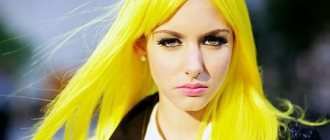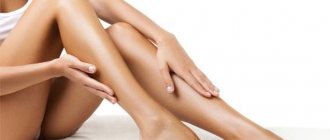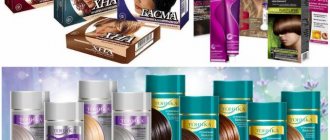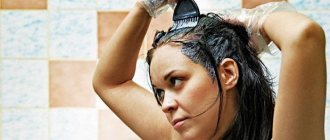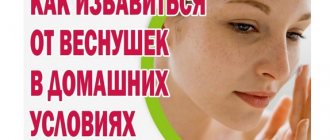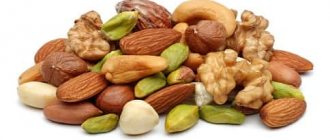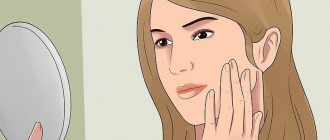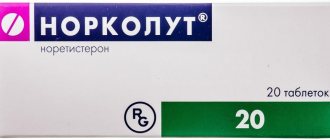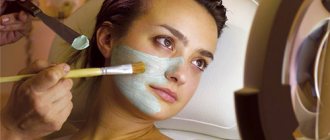White flakes on the hair, called dandruff, are not only unpleasant and unsightly, it is also evidence that something is wrong in the body. How to get rid of dandruff? Dandruff is not as harmless as we think: by forming a crust on the scalp, it blocks air access to the hair roots, after which the hair becomes thinner, weaker and begins to fall out.
Any type of hair can be affected by dandruff – dry, normal, and oily.
The appearance of dandruff can be associated with improper hair care, abuse of hairsprays, gels and hair dyes, frequent use of a hair dryer and even neglect of a hat in winter - then the problem can be solved with the help of cosmetics and folk remedies. But often dandruff is a consequence of health problems: metabolic disorders, poor nutrition, vitamin deficiency, diseases of the gastrointestinal tract - in these cases, complex treatment is required, which is prescribed by a doctor.
There are two ways to get rid of dandruff
: the use of special therapeutic and prophylactic drugs and the use of folk remedies. We will not dwell on the first method, since medications should be prescribed by a dermatologist or trichologist after a thorough examination. But let’s take a closer look at effective folk methods of combating dandruff.
First you need to take care of proper nutrition and rest and general health. It is advisable to reduce the amount of fatty, fried, salty and spicy foods in your diet, limit sweets and eliminate alcohol, but poultry and fish, dairy products, fruits and vegetables should be regularly present on your table.
Particular attention should be paid to hair care products. Sometimes the cause of dandruff can be an incorrectly selected shampoo - in this case, you should replace it with one that suits your hair type. If you regularly dye your hair, it is best to use special shampoos for colored hair: they not only retain color longer, but also contain a complex of vitamins that nourish the scalp and strengthen the roots. Helps get rid of dandruff
and natural hair coloring products made from onion peels, coffee beans, walnut shells, as well as herbal dyes henna and basma. If possible, avoid blow-drying your hair and let your hair dry naturally.
Effectively get rid of dandruff
, and at the same time the following folk remedies help strengthen the hair roots:
Take 1 teaspoon each of mayonnaise, sour cream, castor oil and chalk, stir thoroughly, add 1 clove of finely grated garlic to the resulting mixture. Rub the product into the scalp 15 minutes before washing, then rinse with warm water and wash with regular shampoo. We use the product once a week for 1.5 months;
- mix a glass of vodka with a glass of water, add 1 large pod of hot pepper and leave for a week. We use the infusion every time before washing our hair, rubbing it into the skin with a cotton swab. In a month, the dandruff will disappear;
Mix half a liter of water and the same amount of 6% vinegar and add 100 g of crushed fresh nettle leaves. We wash our hair with this solution every day for 10 days without using shampoo;
Add 2 tbsp to 1 liter of boiling water. spoons of crushed tansy flowers, leave for 3 hours, filter and wash your hair without shampoo after 102 days for a month.;
We get rid of dry dandruff by rubbing a mixture of castor and almond oils in a ratio of 1:3 into the hair roots. After 20 minutes, wash off with mild shampoo.
Now you know how to get rid of dandruff,
and at the same time strengthen your hair: a healthy lifestyle, proper scalp care and effective folk remedies will help you with this.
Wanting to always look perfect, people spend a lot of time on their hair. They often change their hair color to change their image or to cover up their gray hair. Sometimes representatives of the fair sex have a problem with the fact that after dyeing their hair their heads are very itchy, and they do not know what to do about it. Naturally, giving up hair coloring is not an option, especially if you need to hide gray hair. Therefore, you should find out what to do when your head itches, so that you can dye your hair without fear and not suffer from unbearable itching afterwards.
Causes of itching
To decide what to do if your scalp itches after dyeing your hair, you should understand the reasons that cause discomfort. Itching after hair coloring can be caused by:
- Dandruff.
Frequent or incorrect coloring dries out the dermis and causes dandruff. If this problem occurs, it should be treated, otherwise it will worsen over time. - Allergies.
The most allergenic components of paint are ammonia, hydrogen peroxide and paraphenylenediamine, which ensures long-lasting coloring. Allergies may appear after the first hair coloring or over time, after several procedures. It is very good to check for allergies before the painting process by testing it by applying a little paint to your wrist. - Overdrying.
After coloring your hair, itching may occur due to the fact that ammonia and peroxide dry out the scalp, so it is best to choose a dye that does not contain these components. If it is not possible to use ammonia-free paint, then you should resort to coloring shampoos, which do not dry out the dermis so much, and you can also use henna. - Incorrect use of paint.
You may suffer from unbearable itching after coloring your hair if it is not applied correctly. As a rule, the paint package contains instructions that indicate how long the paint will remain on the head. Sometimes, wanting to achieve a better color, girls leave it on their heads. Under no circumstances should you do this, as you can not only dry out the dermis, but also get burned.
Treatment of chemical burns to the head...
Burns on the head can occur as a result of exposure to paint for ... 1% of the total ...
Symptoms and signs of acne on the head
The main sign of acne on the head is itching, which usually accompanies the onset of this unpleasant phenomenon. After 1-2 days, small pink or red convex formations form on the scalp between the hair (most often on partings), rising above the skin. Their sizes can vary from 1-2 mm to a centimeter. There is pain when touched, as well as general pain symptoms, a feeling of tightness, and irritation on the skin.
As the formations mature, a cavity filled with pus is formed on their surface. After 4-5 days, the thin film covering the pimple on the head breaks through and its contents flow out onto the surface of the skin. Some formations pass without forming a purulent nodule. Single pimples may appear between the hair follicles; sometimes they form entire clusters in the form of a rash or large inflamed formations.
The location of acne on the head is the border between the neck and the hair, the back of the head, the partings between the hair, the temples and the upper part of the forehead (especially common in the absence of a headdress in the cold season). Deep pimples can leave scars on the scalp and also cause hair loss.
What to do? A mild form of folliculitis may well go away on its own (in a maximum of two weeks) provided that you live a healthy lifestyle and the immune system functions uninterrupted.
In severe forms, antibiotics or antifungal drugs are prescribed. In each individual case, only a doctor can prescribe diagnosis and treatment.
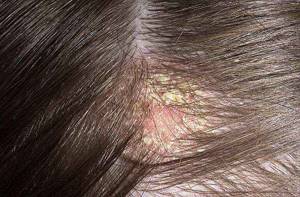
What to do. Contact dermatitis should be treated by a doctor who can determine what treatment is needed in each individual case. To avoid possible relapses, it is very important to correctly identify the allergen.
As with any allergic reaction, treatment can be unpredictable and should always be under medical supervision.
111222.ru
Treatment of itching
If you experience discomfort after coloring your hair, then you should know at least a few ways to deal with it. You can cope with the problems that arise with the help of pharmacies or at home with folk remedies. When you just have slight redness, there is no need for special treatment, but if you feel a burning sensation that does not go away for a long time, then it is better to resort to using special anti-burn products.
You can treat burns:
- Panthenol.
It will relieve pain and speed up the recovery of damaged dermis. - Olazol.
This remedy will also relieve pain very well, relieve inflammation and have an antibacterial effect. - Solcoseryl.
It should be used if you have wounds after dyeing. It has good healing and disinfecting properties. - Furaplast.
This product creates a film that promotes rapid wound healing. It is not used for suppuration and swelling, as it blocks the access of oxygen to the dermis.
If you did not receive a severe burn after applying the paint, then you can cope with minor discomfort without using special means. Various homemade masks are very helpful in combating itching.
One of the most effective is the egg mask:
Causes of dandruff
Dandruff is a lesion of the scalp in which many whitish flakes of dead skin fall off. Particle detachment lasts for a fairly long period and occurs equally in women and men.
Dandruff does not pose any danger to human health, but it is a cosmetic nuisance. What leads to its formation?
Causes:
- Disruption of the natural cycle of renewal of the scalp. In a healthy person, this process takes approximately 28 days, as a result of which the dead particles peel off imperceptibly. But under the influence of many factors, the process accelerates significantly, and the number of scales is many times higher than normal, as a result of which the hair and shoulders become covered with dandruff.
- Endocrine disruptions.
- Disruption of the gastrointestinal tract.
- Activation of fungal diseases.
- Poor lifestyle (drinking alcohol, smoking, constant lack of sleep).
- Hereditary predisposition.
- Regularly wash your hair with very hot water.
- Exposure to hair dryers and low-quality hair cosmetics.
- Stress and regular neuropsychic disorders.
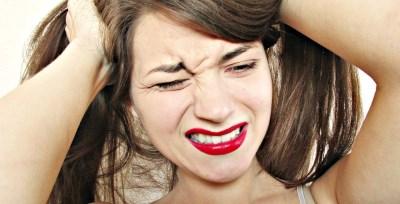
There may be several reasons, the main thing is not to let things take their course and seriously take care of eliminating dandruff, because the active spread of seborrhea in especially severe cases can even lead to baldness.
In particularly advanced cases, you should contact a trichologist who will determine what type of dandruff you have: wet or dry. Based on this, additional tests and complex treatment are prescribed.
But if the situation is not too severe, it is possible to get rid of itchy scalp and dandruff at home.
Rules for choosing and applying paint
To avoid possible consequences after dyeing your hair, you need to follow some recommendations for choosing a suitable coloring agent:
- If there is no need to cover gray hair and just need to slightly tint your hair, then you should choose a first-level dye. They are ammonia-free and therefore will not have such a strong drying effect.
- It is better to buy already proven products. In addition, when purchasing, pay attention to the price. A high-quality product cannot be cheap, since it is made from quite expensive components to ensure long-lasting color.
- Look at the timing of paint sales. An expired coloring agent is more likely to dry out the dermis and lead to scalp burns.
- Do not purchase coloring products from the market. When buying there, you cannot be sure of the quality of the paint, since it is often not certified on the market. And the use of low-quality products leads to itching and problems with the dermis after dyeing.
In order to avoid possible itching, peeling and other unpleasant sensations after painting, you must adhere to several rules for applying paint:
- You cannot mix the components of the coloring agent in a metal container. By reacting with metal, harmful compounds are formed in the paint. It is better to use ceramic or glass dishes for this.
- The paint should be prepared immediately before application. When exposed to air for a long time, it oxidizes. This has a bad effect on the quality of the coloring agent.
- Apply the finished mass first to the roots and then to the hair itself. There should be a minimum amount of product with dermis.
https://www.youtube.com/watch?v=BT8dw0IIrOY Video can't be loaded: How to choose hair dye - Tips Everything will be fine - Everything will be fine - Everything will be fine (https://www.youtube.com /watch?v=BT8dw0IIrOY)
A radical change in image can result in itching, burning, peeling and redness. Knowing how to restore your scalp after unsuccessful dyeing or perming, your skin can be soothed with natural remedies. If symptoms do not go away within a week, consult a dermatologist or trichologist for advice.
Types and symptoms
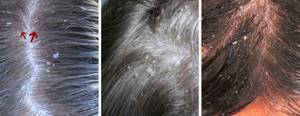
In the human body, there is a constant renewal of cells in all organs, including the skin of the head. Therefore, their moderate rejection is a physiological process and should not cause concern. But if the scalp is too dry, itchy, very flaky, and scales are rejected, then there is a high probability of a fungal infection.
If this unpleasant phenomenon occurs, you should seek qualified medical help. The presence of a fungal disease or other disorder can be detected using laboratory tests.
Timely treatment can significantly improve the condition of the skin, it will stop itching and flaking.
After just two to three weeks, the white flakes on your hair will disappear.
How to prevent skin damage when dyeing
Changing color not only damages the hair, but also the skin. Even soft paint contains chemicals that can cause burns or allergies. The problem can be avoided completely or the effects of chemicals can be mitigated by following simple rules.
How to restore your scalp after a paint burn? Use natural vegetable oils
- Do an allergy test. Apply a little of the prepared composition to the inner bend of your elbow and wait. Avoid dyeing if itching, redness, or peeling occurs.
- Strictly follow the instructions for the specific paint.
- Do not wash your hair before dyeing for at least a day, and preferably longer. Natural fat will be a barrier to aggressive chemicals.
After coloring, apply a healing balm or make a nourishing mask. To find the right product, consult your hairdresser. Among folk recipes, rinsing with a decoction of chamomile or nettle helps.
How to restore your scalp after hair dyeing
Burning and redness of the skin after a color change is an unhealthy reaction. Pay attention to the severity of symptoms and additional signs. General weakness, drowsiness and dry mouth are symptoms of an allergic reaction. Take an antihistamine and see your doctor as soon as possible.
If the painful sensations are clearly localized, then this is most likely a chemical burn from poor-quality paint or due to a violation of the instructions. It is important to prevent an increase in the affected area.
What to do if your head begins to burn unbearably when dyeing:
- Immediately rinse the product from your hair. Do this carefully and for a long time, at least 10 minutes.
- If blisters appear, then this is a third degree chemical burn. Do not self-medicate, this can lead to baldness and more serious problems. Call emergency services or go to the hospital yourself.
- If there is slight redness, a trip to the dermatologist can be postponed for a couple of days. Before this, rinse your skin with a decoction of chamomile, string, and nettle. Try not to scratch any crusts that form.
If the lesion is small and there is slight redness and dryness, then try treating the skin under the hair yourself. First of all, you need to restore the water-salt balance, then nourish it with vitamins.
How to restore your scalp after coloring:
- Change your shampoo. Buy a delicate one, based on soap root. If you couldn’t find such a product, buy a children’s one.
- Get a massage regularly.
- Special scrubs will get rid of flaking and speed up hair regeneration, but they should be applied only after the skin has completely healed, when there is no redness left on it.
- Lubricate the roots with oils (jojoba, burdock, peach, grape seed).
- An egg mask helps a lot. Rub one or two loose yolks into the roots, wait 10 minutes, then rinse thoroughly.
These measures will help relieve minor inflammation, dryness, itching and mild burning.
After painting there should be no burning or redness. A little itching is acceptable, but if it does not go away after a couple of days, then it is time to take serious measures to treat the scalp.
Sometimes after dyeing your hair, a person may feel discomfort, manifested in the form of itching, burning, redness and dandruff. This reaction is the result of exposure of the paint components to the skin.
Most women, in pursuit of an ideal appearance, subject themselves to various procedures, including hair coloring. It is at such moments that the saying “beauty requires sacrifice” fully reveals its meaning. Paints contain a variety of chemical components that can cause significant harm.
Symptoms
A burn to the scalp after dyeing appears immediately. Its main symptoms are:
- pain, burning;
- severe redness;
- local increase in temperature;
- the formation of blisters filled with watery contents;
- the appearance of wounds, ulcers, erosions.
Depending on the depth of damage to the scalp, there are 3 degrees of chemical burns from paint.
- Superficial damage, accompanied by slight pain, burning, redness of the skin, itching and peeling.
- Involvement of deeper structures in pathological processes, manifested by cracking and peeling of the skin, the formation of wounds and blisters with watery liquid. Local symptoms may be supplemented by general manifestations of intoxication: headache, nausea, malaise.
- The spread of damage to all layers of the epidermis and dermis, characterized by severe pain, the formation of large blisters filled with bloody contents, and open oozing wounds on the skin.
In the classification of chemical burns, there is also a 4th degree of damage, in which the damage affects not only the skin, but also the subcutaneous tissue, muscle and nerve fibers. But it is virtually impossible to get a 4th degree burn from hair dye.
Differences from allergies
In addition to burns, the coloring composition can provoke an allergic reaction. With an allergy, unlike a burn, the integrity of the skin is not compromised. There is only redness of the skin, swelling, itching, peeling, and rash. General signs of allergies may also develop: nasal congestion and difficulty breathing, sneezing, watery eyes.
An allergic reaction can occur immediately or within 2 days after hair coloring. To prevent allergies from being complicated by eczema or hives, it is better to consult an allergist or dermatologist if alarming symptoms appear. The most severe manifestations of allergies requiring emergency medical care are angioedema and anaphylactic shock.
Competent hair care
Using untested or cheap dye, women may feel that their scalp itches, burns after dyeing, and in some cases, dandruff appears. Such symptoms indicate that the components of the paint have harmed the skin, and they urgently need additional nourishment.
You can soothe the itching by using specialized shampoos and hair masks. It is not recommended to save on products that provide additional care after the coloring procedure.
Experts who deal with hair problems recommend adding a few drops of vitamin B to the products used after coloring. It nourishes the roots and gives extra shine to the curls.
You can relieve itching by using masks. To carry out procedures, you can contact specialized salons. However, there are many home recipes that have a beneficial effect on the skin, nourishing it and relieving itching.
Few people know that washing colored hair with hot water is not recommended. This makes them dull, brittle, and dandruff appears. It is recommended to carry out this procedure using special shampoos and rinse them off with cool water.
How to get rid of dandruff at home
To begin with, it is important to understand that only external treatment is not enough; it is also necessary to influence the cause of dandruff and itchy scalp from the inside.
To do this, start eating right and go on a balanced diet, limiting yourself to fatty and sweet foods. Instead, add dairy products, fiber, vitamins, nuts and fish to your diet. Dietary recommendations are described in more detail in the table.
Diet guide to get rid of dandruff
| Vitamin A | Vitamin B |
| tomatoes | buckwheat, millet, oatmeal |
| greenery | rice |
| bell pepper | bran and barley |
| carrot | eggs |
| spinach and celery | meat and liver |
| wild garlic | Brewer's yeast |
| rose hip | legumes |

Follow these helpful tips:
- protect your hair and scalp from the sun and hypothermia (wear hats);
- actively strengthen the immune system;
- drink up to 2 liters of clean water per day;
- do not use other people's combs;
- take vitamins;
- use combs with soft bristles;
- When taking a contrast shower, do not forget about the scalp;
- use special shampoos, masks and balms (advisable in cases where there are only external manifestations of the problem);
- do a gentle head massage - this improves blood circulation (you can regularly pull your hair without causing pain, avoiding unpleasant sensations);
- Blow-dry your hair only in extremely rare cases;
- Do not wash your hair with hot water: this provokes excessive sebum secretion).
To get rid of itchy scalp, you can try treating dandruff with professional shampoos. Please note that to combat this problem, the product must contain at least one of the following ingredients:
- Selenium sulfide.
- Tar.
- Salicylic acid.
- Ketoconazole (found in the most popular anti-dandruff shampoo - Nizoral).
- Bifonazole.
- Zinc pyrithione.
- Ciclopirox.
- Clotrimazole.
It is best to buy dandruff treatments not in stores, but in pharmacies. Shampoos are used until dandruff completely disappears.
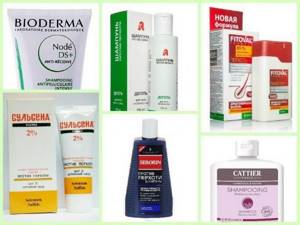
If there is no effect from the use, feel free to change the active substances and try further treatment until you find exactly the remedy that will help you get rid of the unpleasant cosmetic problem forever.
Dealing with the consequences
After the dyeing procedure, hair requires additional care. This can be done using a variety of nourishing masks. These products nourish and envelop each hair, reliably protecting them from the effects of the external environment, strengthening and preventing hair loss.
Chamomile
A decoction or infusion of chamomile will help relieve discomfort. You can water your head with it several times a day. It will soothe irritated scalp and restore damaged tissue.
Yolks
Products made from chicken eggs perfectly relieve itching and prevent hair loss. You will need several yolks and aromatic oil. The product should be used as described below.
- The number of eggs is calculated depending on the length of the hair.
- The yolks are beaten, after which a few drops of oils are added to them.
- The mixture is applied for a quarter of an hour.
- After this time, the mask is washed off and a nourishing balm is applied.
- Nutrients based on kefir, burdock oil or yogurt have proven themselves to be excellent.
Onion+garlic
Hair masks containing onion and garlic juice will help relieve itching and remove dandruff. These remedies have been known since ancient times and have proven themselves in cases where it is necessary to quickly eliminate problems with the scalp.
- The components are mixed in equal proportions.
- After this, oil is added to them (olive or castor is ideal) and lemon juice.
- The product is applied to damp hair after washing your hair 2 times a week and left for an hour.
- After 60 minutes, wash it off with water and shampoo.
- A significant disadvantage of this method is that when wet, your head will smell like an onion-garlic mixture. This disadvantage will be especially noticeable in regions with high humidity.
Apples
You can get rid of dandruff with apples. To prepare, the fruit is grated on a coarse grater, and the resulting pulp is evenly applied to the hair and scalp before washing. The mask is left on for half an hour. During this time, it is recommended to put a cotton cap on your head.
Treatment
If a chemical burn of the scalp occurs during dyeing, treatment is carried out with local agents (ointments, creams, spray) based on dexpanthenol. This:
- Panthenol;
- Bepanten;
- Pantestin.
Medicines based on dexpanthenol have a cooling, moderate anti-inflammatory effect, relieve pain, moisturize, and stimulate the regeneration of damaged skin cells. The drugs are highly safe: they have virtually no contraindications, do not cause adverse reactions or allergies. The products are applied to the affected areas 2-3 times a day. Relief occurs after just a few procedures.
In addition to products containing dexpanthenol, the following drugs can be used for scalp burns:
- Olazol - a spray with benzocaine, boric acid, chloramphenicol and sea buckthorn oil quickly relieves pain, has an antiseptic and antibacterial effect, preventing infection of damaged tissues, promotes healing, applied to the damaged epidermis in a thin layer 1-4 times a day;
- Radevit - an ointment based on vitamins A (retinol), E (tocopherol), D2 (ergocalciferol) has an anti-inflammatory and regenerating effect, moisturizes and softens damaged tissue, reduces skin itching, used twice a day;
- Solcoseryl - the drug has a pronounced reparative effect, activates metabolic processes in damaged structures, stimulates their restoration, is available in the form of jelly and ointment, which is used to treat damaged skin 2-3 times a day.
In addition to the use of healing creams and ointments, solutions of Chlorhexidine and Furacilin are used. Gauze bandages soaked in them are applied to damaged skin in cases where open wounds and erosions form on the scalp after dyeing.
To avoid the development of an allergic reaction, the doctor prescribes antihistamines. Tavegil, Eden, Cetrin and other drugs in this group help reduce swelling and redness of the skin, itching, which invariably occurs during the healing of damaged tissue.
Recovery oils
Hair loss can be prevented by a mask containing burdock oil.
- Oil, lemon juice and honey are mixed in equal proportions (2 tablespoons each).
- Heat over steam until the honey has completely melted.
- The mass is left to cool for some time.
- Two raw yolks of fresh chicken eggs are added to it.
- The resulting mixture is mixed until smooth.
- Rub into the scalp for 3-5 minutes, after which the residue is evenly distributed with a comb along the entire length of the hair.
- The hair is wrapped for an hour. After which the mask is washed off with shampoo.
A mask based on cognac, jojoba and cocoa oils will help relieve itching and eliminate flaking. The oils (1 tablespoon each) are mixed and heated in a water bath, after which cognac (1 tablespoon) is poured into the mixture. The mixture is applied to the hair, left for 15 minutes and then washed off.
You can get rid of dandruff with a vitamin mask based on yolk, as well as argan and burdock oils. The oils are mixed in equal proportions (3 tablespoons each), after which the beaten yolk is added to them. The product is evenly distributed throughout the hair and left for 40 minutes. The head must be covered.
Before using oils, it is recommended to make sure that a person is not allergic to their components. Otherwise, the condition may worsen - dandruff and itching will intensify, red spots and rashes will appear on the skin. Treatment of an allergic reaction may take significantly longer.
If itching appears after dyeing your hair, first of all you need to understand what it is: an allergic reaction or the consequences of a burn caused by the components of the dye. But, whatever the cause of the itching, it is necessary to soothe the skin. If the itching persists for a long time and is accompanied by redness and peeling of the skin, you should consult a specialist - a dermatologist.
Burns after dyeing can cause damage to the hair follicles, which will subsequently lead to hair loss, and in especially serious cases to complete baldness.
If your head itches after dyeing your hair, what should you do? How to avoid itching? Quite a large number of representatives of the fair sex ask similar questions. This is especially true after applying hair dye. After all, when your head constantly itches, it causes discomfort, nervous tension and puts you in an awkward position.
Folk anti-burn remedies
First, the surface of the burns is washed with copious amounts of running water and cooled. First and second degree burns are successfully treated with simple but effective folk remedies obtained from available plant materials, represented by pumpkin pulp, raw chopped potatoes, aloe juice with honey, cabbage, raw egg white:
- the pulp of a ripe pumpkin with a few drops of aloe juice is applied several times a day to the burn surface;
- raw egg white is added to chopped white cabbage, and the finished mixture is applied to the burned scalp;
- Flower honey is added to grated raw potatoes, after which the resulting mixture is applied to the burned areas of the skin.
Bandages with traditional anti-burn remedies must be changed several times a day . The victim is provided with plenty of vitamins and rest for several days.
Variety of hair coloring products
Modern women want to constantly feel presentable and confident. Not only clothes, shoes and makeup help them create their image, but also magnificent hair. Therefore, in order to make the image unsurpassed and look flawless, ladies quite often use various means to color their strands.
The condition of curls is affected not only by unfavorable external conditions, stressful situations, poor nutrition, but also by the use of dyes. All these stressors spoil the hairstyle, make the hairs faded and brittle, and cause itching of the scalp.
Sometimes the head begins to itch immediately after dyeing. In some cases, dandruff may even appear. This indicates that the skin has been damaged by the components of the paint. Most often, the scalp is simply overdried.
Dryness and terrible itching of the epidermis are caused by ammonia and peroxide, which are part of many paints. In some women, these substances cause such irritation that wounds appear on the skin.
In the overwhelming majority, such problems arise when ladies use cheap paints. You should not save money on products that provide coloring and care for colored hair. When coloring your curls, caring for them should always begin with the scalp, as it needs additional nutrition.
Causes
In addition to pigments, hair dye contains alkalis, ammonia and other aggressive chemical components. Also, most paints contain an oxidizing agent, which is most often used peroxide. The highest content of the brightening component is in permanent permanent paints.
Due to the aggressiveness of the chemical composition, all hair dyes require attention and caution when used, however, ammonia dyes provoke the most severe skin irritation.
The most common cause of skin damage is failure to follow the manufacturer's instructions regarding dyeing time and dilution proportions (the paint must be diluted with an oxidizing agent before use).
Less commonly, a chemical burn to the scalp during dyeing occurs due to an allergy to the components contained in the composition, increased skin sensitivity, or the use of low-quality or expired products. In addition, some unscrupulous manufacturers do not always indicate on the packaging complete and reliable information about the components that make up the coloring product and their properties.
Usually, unpleasant consequences occur when you dye your hair yourself with dye purchased in a store. In beauty salons, as a rule, professional hair dyes are used, which have a milder effect on the skin and hair. Therefore, the risk of getting burned when dyeing your hair in a salon is much lower.
Causes of itching
Sometimes the epidermis on the head begins to itch after using high-quality dyes. This happens for a number of reasons:
- Due to an allergic reaction to paint ingredients. To prevent such manifestations, you should use a well-known, suitable remedy. If for any reason it had to be replaced with a new product, then the latter needs to be tested. To do this, before the main use, you need to apply a little dye to a small, delicate area of the skin. If no pathological changes occur on the integument, then you can safely apply the composition to your hair.
- Due to the presence of dandruff. If hair coloring is done incorrectly, dandruff often appears on the epidermis of the head. It won't go away on its own. It can be eliminated with the help of medicated shampoo purchased at the pharmacy.
- If the skin is overdried by paint components. If the dye contains ammonia or peroxide, the skin usually becomes dry. If it is not possible to purchase a product without ammonia, then it is better to dye your hair with henna or a tinting detergent.
- Due to improper use of coloring agent. Before carrying out the procedure for updating your hair color, you should carefully read the instructions. Recommendations must be strictly followed. If the dye should be kept on the strands for 30 minutes, then it cannot be used longer. In most cases, this will not help improve the shade of your curls, but will only harm them and your scalp.
How to get rid of dandruff in 1 day at home
Do you have an important meeting coming up, but your hair condition leaves much to be desired? Then you should take emergency measures to eliminate dandruff and itchy scalp.
Remember: all folk remedies bring benefits no earlier than a week after the start of use!
Do you need to get rid of dandruff at least visually? Read our tips!
First, you need to cleanse your scalp of dead cells. The cheapest and most effective method is using sea salt.
Salt peeling
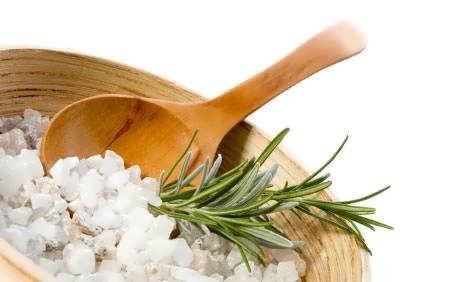
The product is aimed at getting rid of exfoliated cells. Take sea salt (4 tbsp), mix it with 200 ml of kefir, apply to the scalp and leave for 1 hour. Rinse off with your usual shampoo, but not with too hot water, otherwise the milk protein will coagulate and you will have to comb it and your curls for a long time.
Using a blush brush
After exfoliating, washing and drying your hair, take a wide brush and brush away dandruff from visible areas of the head (temples, parting).
Toothbrush
The principle of operation is the same as that of a brush, but the long bristles of the brush help get rid of dandruff along the entire length of the hair.
Scotch
If you have short hair, regular stationery tape can help. To get rid of dandruff, the head is thoroughly washed and dried, then tape is carefully glued to the visible parts and, gently, without tugging, is removed from the curls along with the dandruff.
Important: the product is not suitable for those with long hair!
Sometimes, in order to look 100%, dandruff is blown off with a vacuum cleaner set to the lowest power, or a hairdryer with cold air.
Naturally, all of the above measures are emergency and do not treat the cause in any way. However, if you only have a few hours left, you can use the products to avoid blushing and feel confident and beautiful.
To prevent dandruff, medicated masks are recommended to be used a couple of times a week. Be beautiful and conquer with luxurious hair!
Methods for treating the scalp after coloring
If your hair is damaged, you should not panic. We need to try to reduce negative manifestations. Various care products will help you do this. They must be applied systematically for 4 weeks after the coloring procedure.
In most cases, during this period the itching disappears completely, and the hair regains its natural shine and elasticity.
The following will help heal the skin after coloring your hair:
- Masks made from vegetable and essential oils, egg yolks, curdled milk. They are endowed with anti-inflammatory and nutritional properties. Oils can be applied to the skin and hair in pure form or mixed with each other. Masks are made for about 20-25 minutes. After this, lubricate dry hair with detergent and rinse with warm water. After a few sessions, the dryness will begin to decrease, and the curls will become silky. You can massage your head by rubbing oil into the skin.
- Rinse with herbal infusions. Remedies made from calendula, chamomile, linden, oregano, nettle and yarrow help make hair stronger and reduce skin irritation. Strands should be rinsed with fresh herbal infusions every time after washing your hair.
- Rubbing. Sessions of rubbing onion or garlic juice into the skin remarkably relieve the feeling of itching and activate blood circulation in the hair roots.
- A variety of special hair care products (shampoos, masks, balms). Manufacturers include natural oils, plant extracts and proteins in their composition. They are easy and convenient to use. Such products quickly bring the strands and skin to normal condition.
- Preparations made from apple or raspberry cider vinegar. They are great at eliminating irritation.
Useful videos
Hair restoration at home.
To eliminate the consequences of unsuccessful hair dyeing, namely the treatment of scalp burns, you can use pharmaceutical drugs:
- Panthenol. It has wound-healing, antiseptic, anti-inflammatory properties.
- Solcoseryl. Activates the regenerative properties of the epidermis, normalizes metabolic processes in affected tissues. Apply two to three times throughout the day.
- Furaplast. Eliminates irritation, redness, itching. Has antiseptic properties.
Traditional medicine recipes have also proven themselves to be excellent:
- Peel raw potatoes, grate on a coarse grater, add natural honey, mix thoroughly. Apply applications three times a day to affected areas.
- Beat the egg white and add the white cabbage juice into the resulting foam. Distribute the resulting mass over the scalp and leave for an hour.
- Prepare a decoction of dried St. John's wort and chamomile. Cool to room temperature, rinse twice a day.
To intensively moisturize and accelerate regenerative processes, you can also use scalp care cosmetics from popular brands:
- A mask for the epidermis of the head from Est Etoile stimulates cell regeneration and normalizes oxygen metabolism. The presence of mint and menthol soothes irritated skin and eliminates itching.
- A spray mask from the Polish brand NaturalME based on natural oils and extracts provides an anti-inflammatory effect. Eliminates irritation, activates the restoration of the epidermis of the head.
- The herbal mask from Kleona is designed to protect the skin from burns during the dyeing process, as well as for recovery after the procedure. The unique composition combats dryness and itching.
Strictly following the instructions for hair coloring, using high-quality ingredients, and turning to professionals will not only provide excellent results, but will also protect you from consequences such as chemical burns of the skin.
>
Tricks for caring for colored hair
Small tricks that you should always remember will help prevent itching and irritation of the epidermis after coloring your hair:
- You should never use hair styling products before coloring them. This can cause serious allergies.
- Do not wash dyed strands with hot water - they will immediately fade and become dull. Use cool water and a specially formulated detergent.
- It is necessary to trim the ends of the strands at least once a month.
You should take care of colored hair regularly. You need to do everything right. But the main thing is not to overdo it.
Such work will always be rewarded in the best way: magnificent hair that attracts the eyes of others.
First aid
If burn symptoms occur while dyeing your hair, you should:
- wash off the aggressive composition from the hair;
- rinse your hair with running warm (but not hot) water;
- if the burning sensation is severe, apply a cool compress to the head (but not too cold);
- in case of severe pain, take any painkiller (Baralgin, Solpadein), consult a doctor;
- If you have difficulty breathing and other allergy symptoms, take an antihistamine (Cetrin, Zodak, Tavegil, Eden).
